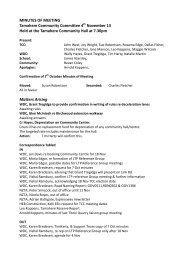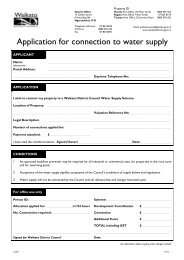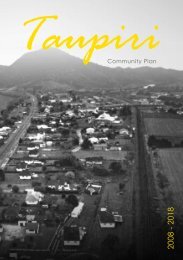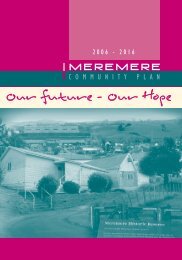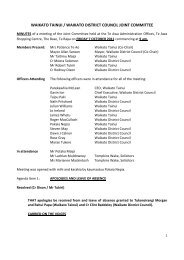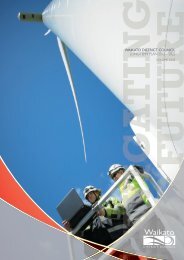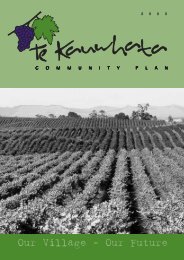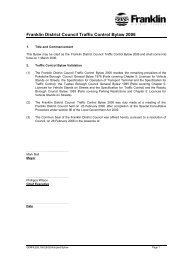1.2 Purpose of this waste assessment - Waikato District Council
1.2 Purpose of this waste assessment - Waikato District Council
1.2 Purpose of this waste assessment - Waikato District Council
- No tags were found...
You also want an ePaper? Increase the reach of your titles
YUMPU automatically turns print PDFs into web optimized ePapers that Google loves.
4.0 Waste within the<strong>Waikato</strong> district4.1 IntroductionThis section focuses on <strong>waste</strong> that is generated within the <strong>Waikato</strong> district. <strong>Waikato</strong> has a number <strong>of</strong> strategic<strong>waste</strong> processing and disposal facilities that accept <strong>waste</strong> from outside <strong>of</strong> the district, and flows <strong>of</strong> thesematerials are discussed in section 5.0.For local government planning purposes, the most important metrics relating to solid <strong>waste</strong> are the tonnageand composition <strong>of</strong> <strong>waste</strong> disposed <strong>of</strong> to landfill and the tonnage and composition <strong>of</strong> ‘diverted materials’.The WMA makes a clear distinction between these two types <strong>of</strong> ‘<strong>waste</strong>’ materials; ‘<strong>waste</strong>’ being defined as“any thing that is disposed <strong>of</strong> or discarded”, while ‘diverted materials’ is defined as “any thing that is no longerrequired for its original purpose and, but for commercial or other <strong>waste</strong> minimisation activities, would bedisposed <strong>of</strong> or discarded”.Measurements <strong>of</strong> <strong>waste</strong> disposed <strong>of</strong> to landfill are more readily compiled and more reliable than measurements<strong>of</strong> diverted materials. Waste to landfill is a well-defined, discrete material flow, handled by a relatively smallnumber <strong>of</strong> operators with all material generally being weighed and recorded at a common point – the landfillweighbridge.On the other hand, there is no general consensus on the boundaries <strong>of</strong> what constitutes a ‘diverted material’.Some materials, such as scrap metal and kraft cardboard collected for recycling, are widely accepted as beingdiverted materials, but for other materials, such as those handled by second-hand dealers, there is no suchagreement. Compounding the difficulties <strong>of</strong> quantifying diverted materials is the large number <strong>of</strong> businessesoperating in the industry (usually undocumented) and the wide range <strong>of</strong> unrelated disposal pathways for thematerials. The commercial sensitivity <strong>of</strong> quantitative information is another major complication, with manybusinesses in the industry being reluctant to voluntarily provide data.In relation to the objectives <strong>of</strong> the NZ Waste Strategy to ‘reduce harm’ and ‘increase resource efficiency’, athird distinct <strong>waste</strong> stream is <strong>of</strong> importance – cleanfill. ‘Cleanfills’ are meant to provide a low-cost alternative tolandfills for inert <strong>waste</strong>s that have no environmental impact when disposed <strong>of</strong> to land. However, as the Ministryfor the Environment’s 2002 guidelines for the management <strong>of</strong> cleanfills states:“...over time the term ‘cleanfill’ has been stretched and modified. Many cleanfills now mistakenly accept a multitude<strong>of</strong> construction and demolition <strong>waste</strong>, contaminated soils, green <strong>waste</strong> and many other materials that can result in anadverse effect on the environment”.It is very difficult to gather any data on <strong>waste</strong> material that is disposed <strong>of</strong> to ‘cleanfills’. ‘Cleanfills’ thatoperate with resource consents are rarely required to report on the quantity <strong>of</strong> material that is disposed <strong>of</strong>.Unconsented ‘cleanfills’ (both legal and illegal) present even greater difficulties with regards to data.As well as these ‘formal’ disposal pathways, <strong>waste</strong> can be disposed <strong>of</strong> through more ‘informal’ pathways,including illegal dumping and, particularly in rural areas, on-site incineration and burial.As a result <strong>of</strong> these factors, <strong>this</strong> summary <strong>of</strong> <strong>waste</strong> data and <strong>waste</strong> flows will focus on <strong>waste</strong> that is disposed<strong>of</strong> to landfill. Data on diverted materials will be limited to the council-controlled recycling systems (ie kerbsiderecycling and transfer station drop-<strong>of</strong>fs) and ‘commodities’ (ie paper, kraft, glass, plastic and metal containers)collected by commercial recyclers.4.2 Waste flows in the <strong>Waikato</strong> districtUsing information provided by the council and private <strong>waste</strong> operators, the flows <strong>of</strong> residual <strong>waste</strong> materials inthe district have been mapped as shown in Figure 2.24



